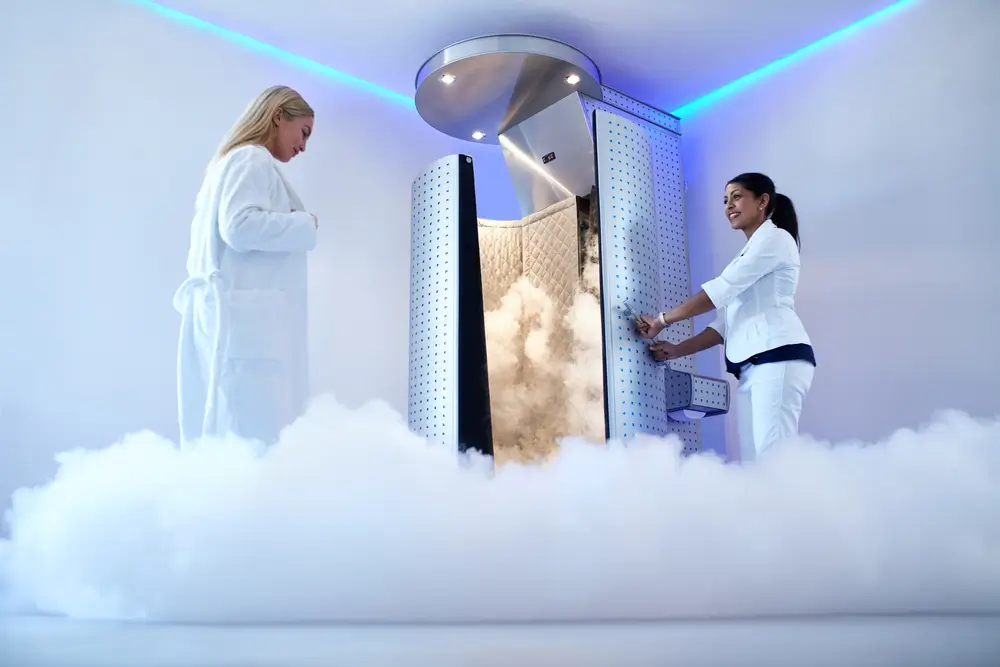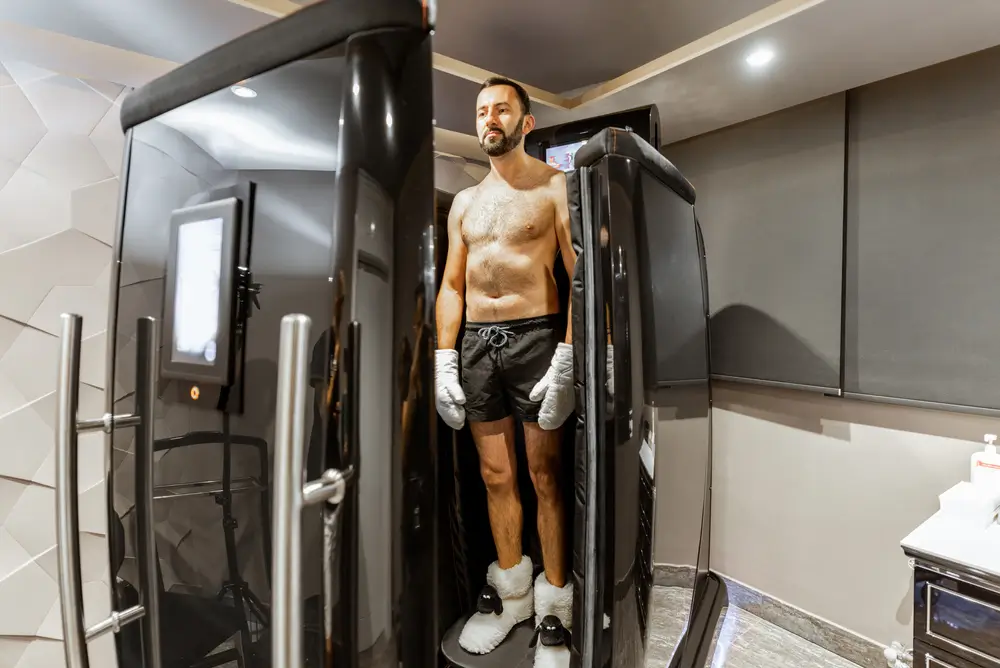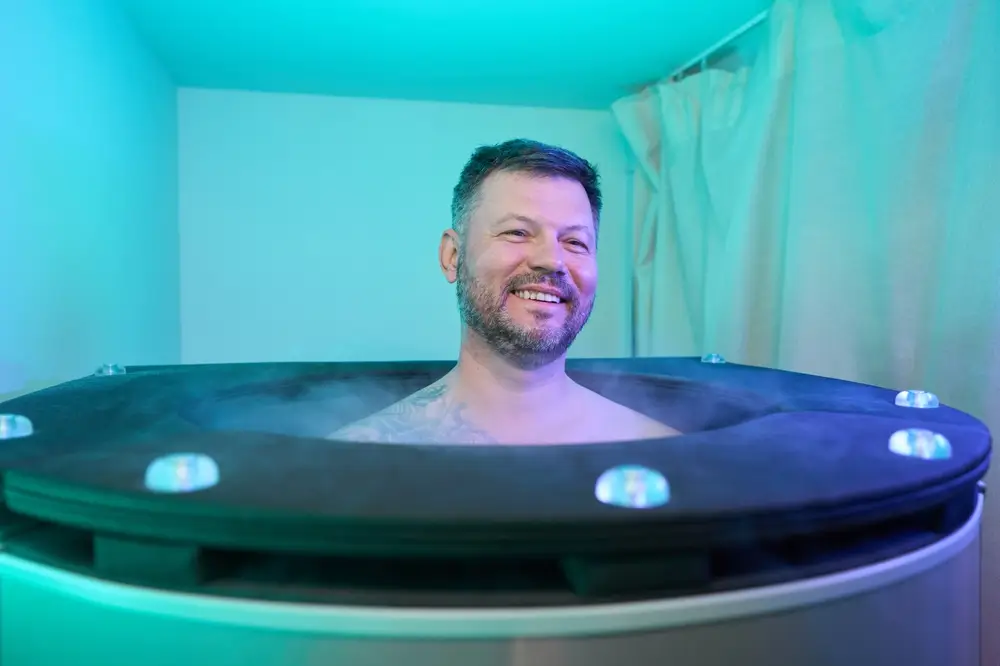Cryotherapy, a term that sounds like it’s straight out of a sci-fi novel, is actually a widely used treatment in the wellness and medical communities. This innovative therapy involves the use of extremely cold temperatures to promote physical and mental health benefits. But what exactly is cryotherapy, and how does it work? Let’s delve deeper into the icy world of cryotherapy and uncover its secrets.
What Is Cryotherapy?
Cryotherapy, literally meaning “cold therapy,” is a technique where the body is exposed to extremely cold temperatures for several minutes. This exposure to subzero temperatures can lead to numerous health benefits, including reduced inflammation, pain relief, and enhanced muscle recovery.
Despite its chilling nature, cryotherapy offers a fast and effective method to support the body’s recovery and rejuvenation processes, making it a popular choice among athletes, individuals seeking pain relief, and those looking for non-invasive wellness therapies.
How Does Cryotherapy Work?
Cryotherapy works by reducing the temperature of your skin’s surface and the underlying tissue. The principle behind cryotherapy is to induce a physiological response to cold. When the skin’s surface temperature drops significantly, the body responds by constricting blood vessels in a process known as vasoconstriction. This reduces blood flow to the areas of the body exposed to the cold, which helps to decrease inflammation and swelling, particularly in injured or overused muscles.
Following this initial response, once you step out of the cold environment, the body then undergoes vasodilation, where the blood vessels expand, increasing blood flow. This enhanced circulation brings nutrient-rich blood to the muscles and joints, accelerating the healing process and flushing out toxins. Additionally, the cold stimulates the nervous system as well, leading to the release of endorphins, the body’s natural painkillers, which can provide a mood boost and a sense of euphoria.
What Is Cryotherapy Used For?
Cryotherapy has been used for various purposes, from sports medicine to beauty treatments. It’s a simple yet powerful way to improve your overall health and well-being. It’s like giving your body a quick, cold shock that can help with a lot of different things. If you are experiencing pain from arthritis or another condition, cryotherapy can help reduce the swelling and pain, making it easier for you to move around and do your daily activities.
Athletes and fitness enthusiasts are turning to cryotherapy as a crucial part of their recovery regimen as well. The treatment accelerates the healing process by alleviating muscle soreness and fatigue, allowing for a quicker return to training. This not only improves performance but also reduces the risk of injuries by ensuring the muscles are well-rested and recovered.
Beyond physical recovery, cryotherapy offers cosmetic benefits. The process stimulates collagen production in the skin, leading to improved elasticity and a reduction in the appearance of wrinkles and fine lines. Regular sessions can result in firmer, more youthful-looking skin.

What Are The Types of Cryotherapy?
Cryotherapy comes in various forms, each designed to cater to different needs and preferences. Whether you’re looking for a quick full-body refresh, targeting specific areas for pain relief, or seeking therapeutic benefits for certain medical conditions, there’s a type of cryotherapy suited for you. Here’s a look at the most common types:
Whole-Body Cryotherapy
In whole-body cryotherapy, you enter a chamber or a small room that surrounds you with cold air, dropping to temperatures as low as -140°C (-220°F). The session lasts for a few minutes, during which the extreme cold envelops your entire body, triggering a systemic response. This method is popular for reducing overall body inflammation, enhancing recovery, and improving mental well-being.
Partial-Body Cryotherapy
Partial-body cryotherapy focuses on specific areas of the body, allowing for targeted treatment. This is done using localized cryotherapy machines that direct cold air or liquid nitrogen to the affected areas. It’s particularly beneficial for athletes with specific injuries or individuals with localized pain or swelling, providing relief right where it’s needed.
Cold-Water Immersion
Cold-water immersion, also known as ice baths, involves submerging the body in cold water for a set period. This method is a traditional form of cryotherapy that reduces muscle soreness and accelerates recovery after physical activity. The cold water helps to decrease muscle inflammation and is a favored routine for many athletes.
Cryoablation
Cryoablation is a medical procedure that uses extreme cold to destroy abnormal tissues, such as tumors or precancerous lesions. It involves applying a cryoprobe with liquid nitrogen or argon gas to freeze the targeted cells, effectively eliminating them without the need for more invasive surgeries. Cryoablation is commonly used in treating various types of cancer and skin conditions.

What Are The Benefits of Cryotherapy
Cryotherapy is a versatile treatment option, offering benefits that extend from physical recovery and pain relief to improvements in mental well-being and sleep quality. These benefits include:
Relieve Chronic Pain
Cryotherapy can significantly alleviate chronic pain, including conditions such as back pain, fibromyalgia, and nerve pain. The cold helps reduce inflammation and numbs the affected area, providing immediate relief.
Reduces Migraine Symptoms
For those plagued by migraines, cryotherapy can offer a beacon of hope. The treatment targets the nerves in the neck, cooling them and reducing the inflammation that contributes to migraine headaches, thus easing symptoms.
Muscle Recovery
Athletes and fitness enthusiasts may find cryotherapy particularly beneficial for muscle recovery. The cold exposure helps reduce muscle soreness and inflammation post-exercise, enabling a quicker return to training routines.
May Improve Sleep
The calming effect of cryotherapy on the body can lead to improved sleep quality. The treatment can help regulate the body’s natural sleep cycles, making it easier to fall asleep and stay asleep.
Increased Energy Levels
Following a cryotherapy session, many individuals report a surge in energy levels. This boost is attributed to the body’s increased metabolic rate as it works to warm up, coupled with the release of endorphins.
Helps Treat Mood Disorders
Cryotherapy can also have a positive effect on mental health, particularly in treating mood disorders like anxiety and depression. The cold triggers the release of endorphins, which can improve mood and reduce stress.
Reduces Arthritic Pain
Individuals suffering from arthritis may find cryotherapy particularly relieving. The treatment can decrease joint inflammation and stiffness, thereby reducing pain and improving mobility.
Help Manage Chronic Skin Conditions
For those dealing with chronic skin conditions such as eczema or psoriasis, cryotherapy can offer relief. The cold can reduce skin inflammation and irritation, leading to an improvement in skin condition and appearance.
How Should I Prepare For Cryotherapy?
Preparing for cryotherapy is straightforward, but there are a few key steps you should follow to ensure your experience is both safe and effective:
- Wear Dry, Loose Clothing
Before your session, make sure to wear or bring along dry, loose-fitting clothing to change into. Moisture on your skin can make the cold more intense, so it’s important to be dry. You’ll typically be provided with gloves, socks, and slippers to protect your extremities from the cold temperatures.
- Remove Metal Jewelry
Metal objects can become extremely cold quickly, potentially leading to discomfort or skin injury. Remove all metal jewelry and other accessories before your session.
- Avoid Applying Lotions or Moisture
Lotions, creams, and moisture can increase the risk of frostbite when exposed to extreme cold. Ensure your skin is free from lotions or moisture before starting.
- Stay Hydrated
While you don’t necessarily need to drink water right before your session, being well-hydrated in general can help improve your circulation and enhance the benefits of cryotherapy.
- Consult With Your Healthcare Provider
If you have any health conditions or concerns, it’s important to consult with a healthcare provider before trying cryotherapy. This is especially crucial for individuals with heart conditions, high blood pressure, or skin sensitivity issues.
- Understand the Process
Familiarize yourself with the cryotherapy process and what to expect during and after your session. Knowing the procedure can help reduce any anxiety and make the experience more comfortable.
What Should I Expect During and After Cryotherapy?
During a whole body cryotherapy session, you’ll first experience an intense cold sensation as the temperature drops rapidly. This initial shock is surprisingly bearable for most people, thanks to the dryness of the air, which makes the cold less penetrating than you might expect. Each session is quite short, lasting only about 2 to 3 minutes, to ensure safety and minimize discomfort. Throughout this time, a technician will monitor you, ready to assist if you feel too uncomfortable. Protective clothing, such as gloves, socks, and occasionally a face mask, is provided to protect sensitive areas of your body from the extreme cold.
How cold is cryotherapy?
Cryotherapy involves exposing the body to extremely cold temperatures, typically ranging between -100°C to -140°C (-148°F to -220°F). These chilling conditions are achieved using liquid nitrogen or refrigerated cold air in cryotherapy chambers or tanks. Despite the intense cold, the sessions are brief, usually lasting between 2 to 3 minutes, to ensure safety and comfort.
After stepping out from the cold environment, you’ll likely feel a rush of energy and invigoration. This is partly due to your body’s reaction to the cold, releasing endorphins, which are natural mood elevators. As your body warms back up, your blood circulation will increase, promoting oxygen and nutrient delivery throughout your body. This can enhance the healing process, reduce inflammation, and improve muscle recovery, especially for athletes. You might also notice immediate pain relief, as the cold can numb nerve endings, offering a respite from chronic pain or injuries.
Additionally, your skin may appear more toned and refreshed from the increased blood flow, and the mood-boosting effects of endorphins can leave you feeling happier and more relaxed for hours or even days after the session.
It’s important to note that individual experiences with cryotherapy can vary. While many enjoy the benefits immediately, others may need multiple sessions to fully appreciate the effects. Always listen to your body and consult with professionals to tailor the cryotherapy experience to your personal health and wellness goals.

What Are The Pros & Cons of Cryotherapy?
Cryotherapy has garnered attention for its innovative approach to health and wellness as it offers a quick and often effective method for managing a variety of physical and mental health issues. Like any treatment, however, it comes with its own set of advantages and potential drawbacks. Understanding these can help individuals make informed decisions about whether cryotherapy is right for them.
Pros
- Rapid Muscle Recovery and Pain Relief: One of the most celebrated benefits of cryotherapy is its ability to significantly reduce muscle soreness and inflammation, making it a favorite among athletes and those with chronic pain.
- Boosts Endorphin Levels: The cold exposure triggers the release of endorphins, the body’s natural mood enhancers, leading to an improved sense of well-being and energy.
- Improves Skin Condition: Regular sessions can stimulate collagen production, leading to tighter, more youthful-looking skin and potentially alleviating conditions like eczema.
- Enhances Sleep Quality: The release of endorphins and reduction in muscle soreness can contribute to better sleep, helping individuals feel more rested and rejuvenated.
- Non-invasive with No Downtime: As a non-invasive treatment, cryotherapy doesn’t require recovery time, allowing individuals to return to their daily activities immediately.
Cons
- Not Suitable for Everyone: People with certain health conditions, such as hypertension, heart disease, or severe asthma, may be advised against undergoing cryotherapy.
- Short-term Effects: The benefits of cryotherapy, while immediate, are often temporary, requiring regular sessions to maintain.
- Discomfort During Sessions: The extreme cold can be uncomfortable for some, especially those not accustomed to cold temperatures.
- Risk of Frostbite: If not properly protected, there’s a small risk of frostbite on exposed skin.
- Accessibility and Cost: Access to cryotherapy might be limited depending on geographic location, and the cost can add up if multiple sessions are needed for sustained benefits.
Getting Started With Cryotherapy at SolCore Wellness
Cryotherapy is a fascinating and beneficial treatment with a range of applications from medical to cosmetic. Understanding what cryotherapy is and how it works is the first step in exploring whether this cold therapy could be beneficial for you. With its numerous health benefits, cryotherapy offers an exciting option for those looking to enhance their physical and mental well-being.
As cryotherapy becomes more popular, it has become more accessible as well. Starting your cryotherapy journey at SolCore Wellness is a step towards enhanced well-being. Located at 11403 Barker Cypress Rd Suite 800, Cypress, TX 77433, SolCore Wellness is a premier facility offering a comprehensive array of wellness services, including cryotherapy. Whether you’re looking to relieve pain, recover from workouts, or simply boost your overall health, their experienced team is ready to support your wellness goals. Contact SolCore Wellness today to book an appointment.
